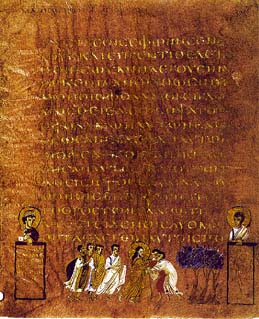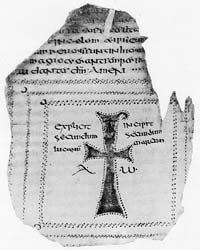Noul Testament
Puteți da chiar dv. o mână de ajutor completându-l cu informațiile și referințele care lipsesc.
Cuprins
Cărţile Noului Testament
Aceste cărţi sunt:
- Evanghelia după Matei
- Evanghelia după Marcu
- Evanghelia după Luca
- Evanghelia după Ioan
- Faptele Sfinţilor Apostoli
- Epistola către Romani a Sfântului Apostol Pavel
- Epistola întâia către Corinteni a Sfântului Apostol Pavel
- Epistola a doua către Corinteni a Sfântului Apostol Pavel
- Epistola către Galateni a Sfântului Apostol Pavel
- Epistola către Efeseni a Sfântului Apostol Pavel
- Epistola către Filipeni a Sfântului Apostol Pavel
- Epistola către Coloseni a Sfântului Apostol Pavel
- Epistola întâia către Tesaloniceni a Sfântului Apostol Pavel
- Epistola a doua către Tesaloniceni a Sfântului Apostol Pavel
- Epistola întâia către Timotei a Sfântului Apostol Pavel
- Epistola a doua către Timotei a Sfântului Apostol Pavel
- Epistola către Tit a Sfântului Apostol Pavel
- Epistola către Filimon a Sfântului Apostol Pavel
- Epistola către Evrei a Sfântului Apostol Pavel
- Epistola Sobornicească a Sfântului Apostol Iacov
- Întâia Epistolă Sobornicească a Sfântului Apostol Petru
- A doua Epistolă Sobornicească a Sfântului Apostol Petru
- Întâia Epistolă Sobornicească a Sfântului Apostol Ioan
- A doua Epistolă Sobornicească a Sfântului Apostol Ioan
- A treia Epistolă Sobornicească a Sfântului Apostol Ioan
- Epistola Sobornicească a Sfântului Apostol Iuda
- Apocalipsa Sfântului Ioan Teologul
Apocrifele Noului Testament
In ancient times there were dozens—perhaps hundreds—of Christian writings claiming Apostolic authorship, but which were ultimately rejects by the Church Fathers in the 27-book New Testament canon. These works are considered "apocryphal", and are therefore referred to in singular as the New Testament Apocrypha. This Apocrypha includes a large amount of gnostic writings, spurious prophecy, fantasy, and in general a number of other heretical teachings. Below are some examples of early apocryphal works (please note this short list is by no means exhaustive):
- Didahia, anonymous instructional text which is considered Orthodox and studied by patristic scholars; written c. AD 50–120.
- Gospel of Thomas - anonymous collection of (Gnostic) sayings attributed to Jesus Christ; written c. AD 50–140.
- Gospel of Peter, anonymous Synoptic narrative; written c. AD 70–160.
- Epistle of Barnabas - anonymous letter of counsel to an unknown audience; written c. AD 80–120.
- Greek Gospel of the Egyptians, anonymous Gospel narrative; written c. AD 80–150.
- Gospel of the Hebrews, anonymous Gospel narrative; written c. AD 80–150.
- 1 Clement, letter of counsel probably composed by Clement, Bishop of Rome, and addressed to the church in Corinth, whose teaching is orthodox but not as worthy of inclusion in the canon as the other epistles; written c. AD 95–96.
- Apocalypse of Peter, anonymous prophecy concerning the end times; written c. AD 100–150.
- The Shepherd of Hermas, anonymous Christian text purportedly by the Apostle Hermas; contains a broad range of content, including prophecy, direct instruction and parables; written c. AD 100–160.
- Gospel of Judas, anonymous gospel narrative attributed to Judas Iscariot; written c. AD 130–170. This "gospel," as well as several of the above like the Shepherd of Hermas, are part of the pseudepigrapha, or writings claiming to be by someone else other than their real author (generally someone more prestigious).
- Protoevangelion of James, a second-century text purported to have been written by James the Just, the brother of the Lord.
Limba Noului Testament
The common language spoken in the Holy Land at the time of Jesus was Aramaic. However, the original text of the New Testament was most likely written in Koine Greek, the vernacular dialect in 1st century Roman provinces, and has since been widely translated into other languages, most notably, Latin, Syriac, and Coptic. (However, some of the Church Fathers seem to imply that Matthew was originally written in Hebrew or more likely Aramaic, and there is another contention that the author of the Epistle to the Hebrews wrote in Hebrew, which was translated into Greek by Luke. Neither view holds much support among contemporary scholars, who argue that the literary facets of Matthew and Hebrews suggest that they were composed directly in Greek, rather than being translated.)
It is notable that many books of the New Testament, especially the Gospel of Mark and the Book of Revelation, are written in relatively poor Greek. They are far from the refined Attic Greek or Classical Greek found composed by the higher classes, ruling elites, and trained philosophers of the time. Relative exceptions to this include the gospels of Luke and John and the Acts of the Apostles.
Legături externe
- (ro) Noul Testament - Catehismul Bisericii Ortodoxe, de Sfântul Nicolae (Velimirovici)
- New Testament at Wikipedia
- Our Faith: Biblical Studies (GOARCH)

